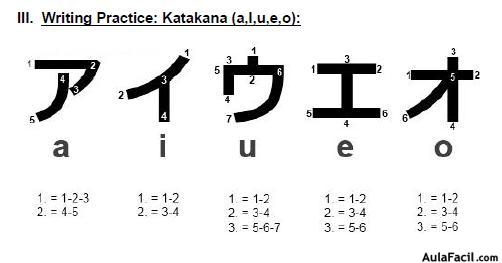Nationality words
Content: Nationality words, The “A” Line of Katakana (a,i,u,e,o), introduction of present tense verbs, desu and masu form.
Aim: How do I say where I am from?
New Vocabulary:
Japanese | Romaji | English |
(スペイン) | supein | Spain |
(スペインご) | supein go | Spanish language |
にほん | nihon | Japan |
にほんご | nihon go | Japanese language |
どこ | doko | where |
から | kara | from |
きました | kimashita | came |
いつ | itsu | when |
きょねん | kyonen | Last year |
べんきょう | benkyo | to study |
しています | shimasu | Verb – to do (formal) |
も | mo | too |
と | to | And / with |
むずかしい | muzukashii | difficult |
かんたん | kantan | easy |
Lesson Point:
Japanese verbs: Japanese verbs are very easy to use compared to English and other languages where the verbs are changed based on the subject. For example, in Spanish the infinitive of the verb “to eat” is “comer” but “comer” changes its form for every subject – yo como, tu comes, el/ella come, ellos comen, nosotros comemos, vosotros comeis. Ok, we know this is not a Spanish lesson. Anyway, the point is that in Japanese, the stem usually stays the same or only changes once according to the relationship between the speaker and the listener.
Masu form: For this lesson, we will begin using verbs with the standard formal ending of “ます“ or Masu. This is the ending you will use when you are speaking to someone who is more senior to you, to someone you don’t know, or someone you need to have a formal relationship like a customer or a boss.
Also, most verbs have an infinitive form (“to…”) that is used when speaking informally or when verbs are combined in a sentence. We’ll talk more about this in a later lesson. But the rule for using the masu form is basically: [Stem+Masu] – The End. So the most important thing to do is to memorize the infinitive of the verb and the stem so that you can use them both ways.
Look at the chart below:
Infinitive / Plain form | Stem | Masu form |
To eat - たべる | たべ | たべます (Tabemasu) |
To speak - はなす | はな | はなします (Hanashimasu) |
To go - いく | いき | いきます (Ikimasu) |
To come - くる | き | きます (Kimasu) |
To do -する | し | します (Shimasu) |
Converting the infinitive to the stem: Most verbs in Japanese are regular verbs and follow a very simple rule for converting them to stem or root so that the masu ending can be applied. Drop the last sound – see the two examples in green above. Once the stem is made, then you add the ”ます” ending to complete the word.The irregular verbs are different because the stems often do not look like the infinitive so these have to be memorized. Don’t worry, you can do it!
Masu+ka = a question ”ますか” : As we mentioned in Lesson 4, “Ka” turns a statement into a question. In Lesson 4 we talked about changing the “desu” ending to “desuka” to make it into a question. Here we are going to add “ka” to the end of masu to create a question. For example: “ごはんをたべましたか。”
Sample Sentences:
Ricardo, Ana & Yamada san
Y: Ricardoさんとアnaさんは、どこからきましたか?(Ricardo and Ana, where are you from?)
Ricardo san to Ana san wa, doko kara kimashita ka?
R: わたしたちはsupeinからきました。(We are from Spain/ We came from Spain)
Watashi tachi wa supein kara kimashita.
Y: いつにほんにきましたか?(When did you come to Japan?)
Itsu nihon ni kimashita ka?
R: きょねんきました。(Last year/ We came last year)
Kyonen kimashita
Y: わたしはスペインごをべんきょうします。(I study Spanish.)
Watashiha supein go o benkyo shimasu.
R: わたしたちもにほんごをべんきょうします。(We, too (also), study Japanese.)
Watashi tachi mo nihongo o benkyou shimasu.
Y: にほんごはむずかしいですか?(Is Japanese difficult?)
Nihon go wa muzukashii desuka?
R: いいえ、かんたんです。(No. It’s easy.)
Iie, kantan desu
A: はい、とてもむずかしいです。(Yes. It’s very difficult.)
Hai, totemo muzukashii desu
| S-12-1 |
II. Mini Quiz – Fill in the spaces below (Test your knowledge ):
Infinitive | Stem | “Masu” form | “Masuka” |
いく |
|
| いきますか |
する | し |
|
|
|
| たべます |
|
くる |
|
| きますか |
はなす |
|
|
|
III. Writing Practice: Katakana (a,I,u,e,o):

Quiz Answers:
Infinitive | Stem | “Masu” form | “Masuka?” |
いく | いき | いきます | いきますか |
する | し | します | しますか |
たべる | たべ | たべます | たべますか |
くる | き | きます | きますか |
はなす | はなし | はなします | はなしますか |
